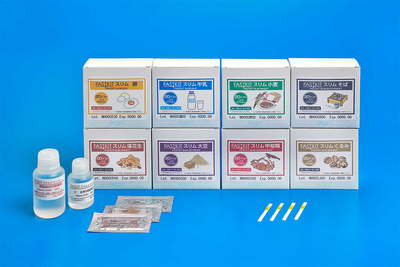FASTKIT Slim series

FASTKIT Slim series is a simple immunochromatography-based detection kit for food allergens. It can detect many different antigenic proteins, delivering performance that minimizes missed detection. After application of a pretreated sample solution, the result will become available in only 15 minutes.
"Walnut" is a new addition to the lineup.
Features
- Simple operation
- No heating required during extraction
- Targeting multiple antigenic proteins, minimizing missed detection
- Rapid measurement (approximately 15 minutes after sample application)
- Ideal for cleanliness check for inspection/manufacturing lines of intermediate products (wipe test)
- Diverse lineup
Egg, Milk, Wheat, Buckwheat, Peanuts, Soybean, Crustacean, Walnut
Data
Difference between FASTKIT ELISA series and FASTKIT Slim series
| FASTKIT ELISA series | FASTKIT Slim series | |
|---|---|---|
| Principle | ELISA | Immunochromatography |
| Specification | -Limit of detection : 0.78ng/mL -Range of quantification : 2.5-50ng/mL (Equivalent to 1 - 20ppm in food) |
-Detection sensitivity : 25ng/mL (Equivalent to 5 ppm in food) It may vary depending on the analyst or testing environment. |
| Advantages | -Content confirmable -High detection rate from heated/processed foods |
-Results available on site -No special equipment required, simple testing procedure |
| Disadvantages | -Results available on the following day -Measuring equipment (Plate reader) required |
-Content not confirmable |
| Example of use | [In laboratories] -When new products are registered -When certificates for external submission are prepared -Confirmation of finished products/ingredients |
[At production sites in factories and cooking sites etc.] -Monitoring in process control -When urgent confirmation is required -Measures against contamination |
How to use FASTKIT ELISA series and FASTKIT Slim series depending on the situation

Product List
- Open All
- Close All
FASTKIT slim series [Immunochromatography]
For research use or further manufacturing use only. Not for use in diagnostic procedures.
Product content may differ from the actual image due to minor specification changes etc.
If the revision of product standards and packaging standards has been made, there is a case where the actual product specifications and images are different.



